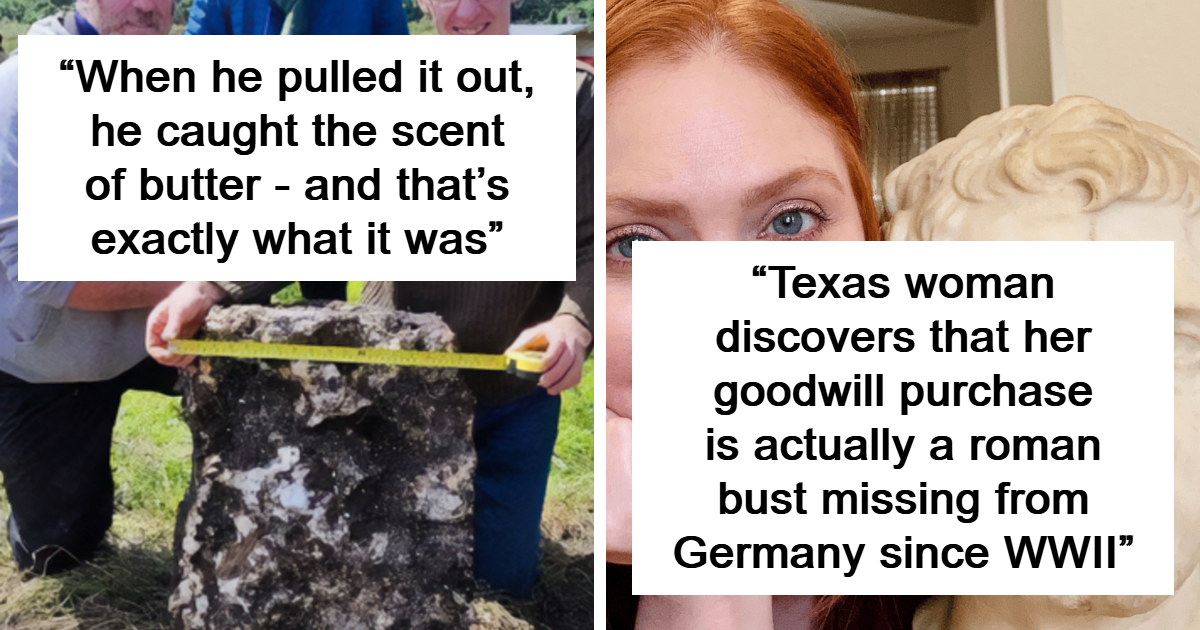45 Mind-Blowing Facts You Never Knew Existed—Prepare to Be Amazed!
Ever wonder how history might look if it were less about dusty dates and more about jaw-dropping moments and secret discoveries? Well, buckle up, because ‘History Uncovered’ peels back the curtain on the past’s best-kept stories — from a POW’s clever survival hacks in Vietnam to ancient bog butter that still smells like your grandma’s kitchen. It’s like your grandpa’s war tales met Indiana Jones and decided to spill some serious tea. Ready to dive into the odd, the miraculous, and the downright unbelievable footprints our ancestors left behind? Let’s flip the page on history, one fascinating fact at a time.
Who are we but a collection of stories? People, cities, countries—all carry memories. ‘History Uncovered‘ is not just about dates and army sizes; this Instagram account aims to show you the world in a way you haven’t seen, and it does this by digging up the small details that make the big picture clearer. From ancient civilizations to the recent past, continue scrolling to check out the footprints left behind by those who came before us.
American servicemen at the Hỏa Lò prison camp in Vietnam made a pact that any prisoner who accepted an early release and left without the rest of them would be considered a traitor. However, they made an exception for Doug Hegdahl. When Hegdahl had arrived at the “Hanoi Hilton” in April 1967, he’d pretended to be illiterate, and the guards thought he was so harmless that they essentially gave him free rein of the camp. Soon, he’d memorized the names and personal information of 256 of his fellow POWs, so when he was offered early release in August 1969, his superiors urged him to go so he could share valuable information about the camp with U.S. military officials. Hegdahl agreed, and the intelligence that he supplied allowed 63 servicemembers to be reclassified from MIA status to POW status and put pressure on the North Vietnamese to stop torturing captured American troops, potentially saving countless lives.
Charles Lightoller survived the sinking of the Titanic by clinging to an overturned lifeboat, but that didn’t stop him from returning to the sea. In the following years during World War I, Lightoller served in the Royal Navy and was decorated twice for his actions in combat.
Following the war, Lightoller retired and bought his boat, “Sundowner,” to cruise around northern Europe with his wife. However, as World War II commenced, the British government called for civilian boat owners to help rescue Allied soldiers in what is now known as the Dunkirk Evacuation. Lightroller demanded to captain his boat and was able to rescue 260 men.
A nine-year-old boy named Ben Witten was recently studying the Stone Age exhibit at the Worthing Museum in southern England when he spotted a prehistoric ax that looked remarkably similar to a rock he kept in his bedroom. He found the stone at Shoreham Beach three years ago and picked it up because he “just thought it looked different.” When Ben got home, he and his mom emailed photos of the shiny piece of flint to the museum’s curator of archaeology — who informed them that it was actually a Neanderthal hand ax. The artifact is between 40,000 and 60,000 years old and is “so rare that most qualified archaeologists would never find one themselves.”
Roughly 700 years ago, a French-language sequel to the legend of King Arthur known as the Suite Vulgate du Merlin became a “medieval best seller.” Its first half tells the story of how Sir Gawain, equipped with Excalibur, defeated the invading Saxons alongside Arthur. The story’s second half is an unusual tale of a shapeshifting Merlin who appears to Arthur as a blind harpist and then as a balding child with no underwear, before finally joining the king in battle and turning his flag into a dragon that breathes fire upon their enemies.
Though this tale was popular in the medieval era, it eventually fell out of favor — so much so that a wealthy family in southern England used their 13th-century copy for scrap paper in the early 1500s, tearing and folding it to use as bookbinding material for property records. These records languished in archives and libraries for the next 500 years, during which time the number of surviving copies of the Suite Vulgate du Merlin dwindled to less than 40. But in 2019, researchers at the University of Cambridge happened upon this scrapped copy of the legends. Now, after years of painstaking imaging and digital unfurling, they’ve finally revealed this legend in full.
In the words of his mother, Rowan Brannan of Bognor, England has “always been into finding all sorts of bits and pieces.” So when the two were out for a walk with their dog and 12-year-old Rowan found a shiny piece of metal, his mom didn’t think it was anything special. “He kept holding this bit of metal, convinced that it was actual real gold,” she recalled. “I thought it was just some strapping from a fence or something.”
But Rowan remained convinced and began researching how to identify real gold, encouraged by the fact that his find seemed to meet all of the criteria. Then a metal detectorist acquaintance of theirs saw the piece and showed it to her expedition group’s leader, who recommended they bring it to a government specialist. Finally, Rowan was delighted to learn that his discovery was a Roman bracelet dating back 2,000 years. A gold band of the armilla type, this bracelet would have been given to a Roman soldier as a show of respect for valor and service.
Built on Egypt’s Mediterranean coast during the third century B.C.E., the Lighthouse of Alexandria has long been known as one of the Seven Wonders of the Ancient World. Standing more than 330 feet high, it was one of the tallest structures in the world for centuries and it stood for 1600 years before finally succumbing to an earthquake in 1303. Its sunken ruins, at least 3,300 pieces in all, weren’t rediscovered until 1968 and weren’t explored until 1994. Now, archaeologists have just pulled 22 of the lighthouse’s largest pieces out of the Mediterranean, with some weighing as much as 80 tons. These colossal stone blocks include parts of everything from its threshold to its base to its door.
A three-year-old girl named Ziv Nitzan was recently on a family trip to the ancient Israeli city of Tel Azekah — the place where the Bible says David defeated Goliath — when she made a stunning discovery. She was walking along a path at the base of the site with her sisters and bent down to pick up a small stone scattered among countless identical rocks. She rubbed the sand off of it to reveal an engraving of scarabs, beetles that were sacred in ancient Egypt. Ziv’s family realized the artifact’s importance and reported the discovery to the Israel Antiquities Authority — and experts soon identified the object as a 3,800-year-old Canaanite amulet.
Two metal detectorists were recently searching a beach along the Baltic Sea in northern Poland when they came across an unexpected find. A storm had knocked off pieces of the cliff along the shore, and embedded in one of these chunks was a nine-inch-long dagger. The “richly ornate” artifact was engraved with crescent moons and stars, and a design running down the center of the blade may have been meant to represent a constellation. The metal detectorists quickly notified The Museum of the History of Kamień Land, where experts determined that the dagger was roughly 2,800 years old.
Now, the weapon is undergoing additional analysis that researchers hope will reveal whether it belonged to a wealthy warrior — or if it was used by an ancient “solar cult” for rituals.
When a homeowner in New York was recently doing yardwork and stumbled upon something in the dirt, they initially thought it was just an old baseball — but it turned out to be part of a mastodon jaw. After further digging, the homeowner unearthed the entire jaw of an adult mastodon dating back at least 13,000 years. Local archaeologist Cory Harris confirmed their discovery and said he was “crazy excited,” adding that, “It was the same old-school excitement I felt when I got into this field in the first place.” Now, Harris is hoping that the homeowners will let him keep digging to see if the complete remains of this prehistoric behemoth are sitting just below this suburban home
“I opened the package, removed the bubble wrap, and staggered back in awe. My hands were shaking as I held it up to the light… I knew that only one person could’ve produced something like this.”
About 13 years ago, 11-year-old Mat Winter was exploring a dump in England when he discovered an ornate engraving hidden in a heap of trash in the back of a woman’s car. The woman said Winter could keep it, and he took it home, storing it in a cupboard for over a decade. Recently, Winter decided to get the artwork appraised “to see if it was as special as it looked” — and found out that it was a 500-year-old print of a woodcut engraving by the legendary German Renaissance artist Albrecht Dürer. Now, the piece is headed to auction, where it could fetch tens of thousands of dollars
Archaeologists excavating the remains of Rome’s “Golden House,” the opulent palace that Emperor Nero built for himself right across the street from the Colosseum, recently uncovered a rare chunk of the prized pigment “Egyptian Blue.” Known for its striking cerulean hue, this dye was first created circa 3250 B.C.E. and was soon used throughout the ancient world in everything from Egyptian mummy portraits to Roman frescoes to Greek statues. And while archaeologists usually only uncover mere scraps or powdery remnants of this pigment today, the newly-found chunk is an astonishingly large artifact measuring six inches across and weighing more than five pounds. Researchers found it near a pool once used to mix dyes and they believe it was going to be used to paint frescoes on Nero’s walls.
The movie “Indiana Jones and the Last Crusade” features an ancient tomb in Jordan known as “The Treasury” that was carved into the desert stone by the Nabataean people around the first century C.E. The wealthy Nabataeans were known for their luxury trade network of goods such as gold, ivory, and perfumes that extended as far west as Italy. Since the 18th century, artifacts found off the coast of Pozzuoli, a coastal city near Naples, have pointed to the presence of a Nabataean temple in the area — and now archaeologists have finally found it.
While mapping the seafloor, researchers discovered two large rooms submerged in the port of Pozzuoli, which was dry land 2,000 years ago, before volcanic activity changed the coastline. Each room contained a marble slab with the Latin inscription “Dusari sacrum,” or “consecrated to Dushara,” the main god of the Nabataeans. One of the rooms also held two marble altars that would have once displayed stones sacred to the religion. Archaeologists now believe that the temple was intentionally buried with a mix of concrete and broken pottery around 100 C.E., potentially because the Nabataeans were leaving the region.
In the early 1700s, wealthy British trader Joseph Fernley-Maisters and his wife Sarah grew distrustful of the recently-formed Bank of England and its new paper currency. Eventually, they decided to take a portion of their vast riches and simply stash it under the kitchen floor of their Yorkshire home. And after they both died and the family line dwindled in the 1740s, their trove of gold coins simply sat there, forgotten and untouched for the next 280 years.
Finally, in 2019, the couple who’d bought the house 10 years prior decided to redo the kitchen floor. And sure enough, just six inches below the surface, they stumbled upon an earthenware container holding the Fernley-Maisters cache of gold. Experts have now valued the find at $288,000, and once its sale at auction is complete, the lucky couple will get to keep most of the proceeds.
SkaterTrainers- Skateboard Tricks Fast No Experience Needed- Fun, Safe, and Easy- Ollies, Kickflips and More- All Ages- Accessories Make Great Stocking Stuffers Gifts for Teen Boys and Girls
$26.00 (as of October 27, 2025 18:42 GMT +00:00 - More infoProduct prices and availability are accurate as of the date/time indicated and are subject to change. Any price and availability information displayed on [relevant Amazon Site(s), as applicable] at the time of purchase will apply to the purchase of this product.)1MORE Triple Driver In-Ear Earphones Hi-Res Headphones with High Resolution, Bass Driven Sound, MEMS Mic, In-Line Remote, High Fidelity for Smartphones/PC/Tablet - Silver
$69.99 (as of October 27, 2025 18:42 GMT +00:00 - More infoProduct prices and availability are accurate as of the date/time indicated and are subject to change. Any price and availability information displayed on [relevant Amazon Site(s), as applicable] at the time of purchase will apply to the purchase of this product.)Joking Hazard by Cyanide & Happiness - 360+ Funny & Inappropriate Comic Cards, Hilarious Party Games | Includes Add-Your-Own-Words Cards
(as of October 27, 2025 18:42 GMT +00:00 - More infoProduct prices and availability are accurate as of the date/time indicated and are subject to change. Any price and availability information displayed on [relevant Amazon Site(s), as applicable] at the time of purchase will apply to the purchase of this product.)Rhythm Superfoods Cripsy Beet Chips, Salted, Organic and Non-GMO, Vegan/Gluten-Free Superfood Snacks, 1.4 Oz (Pack of 4)
(as of October 27, 2025 18:42 GMT +00:00 - More infoProduct prices and availability are accurate as of the date/time indicated and are subject to change. Any price and availability information displayed on [relevant Amazon Site(s), as applicable] at the time of purchase will apply to the purchase of this product.)RIVER OF GOODS Coastal 52 Inch Wooden Bead LED Ceiling Fan, Cream
$198.00 (as of October 27, 2025 18:42 GMT +00:00 - More infoProduct prices and availability are accurate as of the date/time indicated and are subject to change. Any price and availability information displayed on [relevant Amazon Site(s), as applicable] at the time of purchase will apply to the purchase of this product.)gbs LEGAL LOOTING GIVEAWAY
WIN $500 OF SHOPPING!
This will close in 0 seconds



































